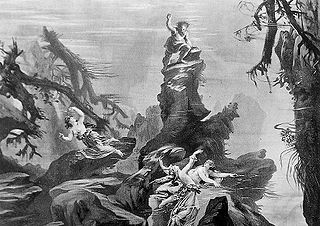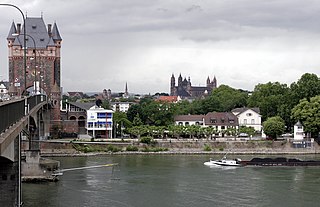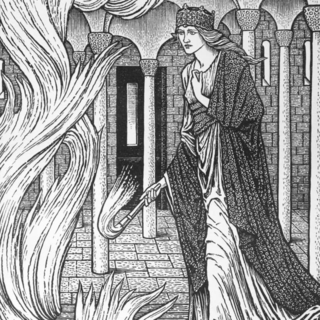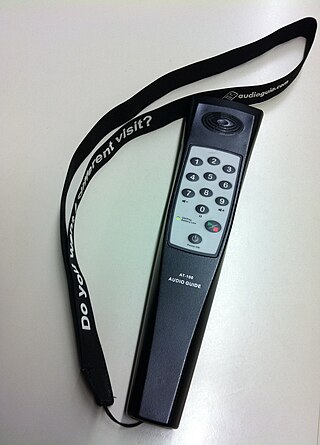Themed rooms
The initial spatial concept contained three rooms with dedicated to different concepts: the Tower of Visions, the Audio tower and the treasure room. The underground treasure room has been closed in 2007, due to technical reasons. Since 2008, the room contains the so-called laboratory of myths, in which visitors can once again recap their museum tour. The laboratory of myths is barrier-free. Especially visitors with health issues, who are not able to participate in the audio tour through the upper towers, can view the guided tour via monitors. With its different media techniques and a big screen, the room can be used by groups for educational purposes.
The Tower of Vision
In the Tower of Vision the visitors are presented to the main aspects of the saga, including its origins and historical context. At the same time it also traces the history of reception, which ranges from mythification to the declaration of the saga as a “national myth”. The narrator helps to “record the invisible threads, which during all the centuries linked together” [translated from German]. The Tower of Vision is installed in one of the medieval defense towers and is dominated by a high, oscillating iron pendulum in the form of a spindle, around which the spiral stairs are arranged. Glowing pictures are attached to the ribs of the sparkling, golden spindle, representing the “Rütlin” (little rod), which is the talisman of the Nibelungen treasure.
The Audio Tower
The Audio Tower is laid out as the scriptorium of the narrator. Here, visitors can sit on audio chairs and listen to passages from the original song, spoken in Middle High German and translated simultaneously. Visitors also learn about the contemporary everyday culture and high culture, which have influenced the author of the Song of The Nibelungs. Pictures, which visitors could also see in the Tower of Vision function as illustrations of the text passages and are now explained in more detail.
The Myth Lab
The “Myth Lab”, which is located in an underground room, provides visitors with the opportunity for quiet contemplation after the two-hour tour through the museum. The entire text by the anonymous poet can be accessed again here, and the Rütelin, a 17,5m column of pictures located in the Tower of Vision, is graphically depicted and can be viewed from all sides and angles. An internet search function is provided for student groups to research information for presentations or the like, and several flash movies and short documentaries can also be found there. The documentaries deal with the themes of Worms, modern and classic myths, and the Nibelungenlied. In addition, a “master terminal” and a ceiling projector provide presenters with the option of adding and presenting their own content.
The “myth lab” is also used for varying special presentations.
Reception
Before the official opening of the museum the “virtual treasure” was presented on two symposia in Paris in 2000, as well as in Boston in 2001. The invitations for both symposia were sent by the Goethe Institute and the two events encountered a huge media response in France, Canada, the United States and Japan:
"A high-tech, cutting-edge interpretation of the Nibelungen myth…" Boston Digital Industry: Treasure of the Nibelungs (May 2001)
"Au-delà de la performance technique qui sait se faire oublier, les auteurs ont réussi une œuvre d'une grande poésie…" Libération: Tragédies en sous-sol (December 8, 2000)
"Sitôt que l'on y entre, en sentira son rhythme, sa joie ou ses tourments." Le Devoir: Un trésor virtuel sous la ville (January 20, 2001)
The official opening of the museum was also regarded as a success by a number of nationwide media:
"In the new Nibelungen Museum Worms the nebulous story is visualized. Thousands of pictures, texts and sounds result in a fantastic image of the medieval heroic epic." Frankfurter Rundschau (August 11, 2001)
"… a testimony deserving attention." Frankfurter Rundschau (August 21, 2001)
"The Nibelungenmuseum Worms virtually revives a piece of German world literature." Süddeutsche Zeitung, (August 20, 2001)

Der Ring des Nibelungen, WWV 86, is a cycle of four German-language epic music dramas composed by Richard Wagner. The works are based loosely on characters from Germanic heroic legend, namely Norse legendary sagas and the Nibelungenlied. The composer termed the cycle a "Bühnenfestspiel", structured in three days preceded by a Vorabend. It is often referred to as the Ring cycle, Wagner's Ring, or simply The Ring.

Worms is a city in Rhineland-Palatinate, Germany, situated on the Upper Rhine about 60 km (40 mi) south-southwest of Frankfurt am Main. It had about 82,000 inhabitants as of 2015.

Das Rheingold, WWV 86A, is the first of the four epic music dramas that constitute Richard Wagner's Der Ring des Nibelungen. It was performed, as a single opera, at the National Theatre Munich on 22 September 1869, and received its first performance as part of the Ring cycle at the Bayreuth Festspielhaus, on 13 August 1876.

The Nibelungenlied, translated as The Song of the Nibelungs, is an epic poem written around 1200 in Middle High German. Its anonymous poet was likely from the region of Passau. The Nibelungenlied is based on an oral tradition of Germanic heroic legend that has some of its origin in historic events and individuals of the 5th and 6th centuries and that spread throughout almost all of Germanic-speaking Europe. Scandinavian parallels to the German poem are found especially in the heroic lays of the Poetic Edda and in the Völsunga saga.

Brunhild, also known as Brunhilda or Brynhild, is a female character from Germanic heroic legend. She may have her origins in the Visigothic princess and queen Brunhilda of Austrasia.

In Germanic heroic legend and folklore, Fáfnir is a worm or dragon slain by a member of the Völsung family, typically Sigurð. In Nordic mythology, he is the son of Hreiðmarr, and brother of Regin and Ótr and is attested throughout the Völsung Cycle, where, Fáfnir slays his father out of greed, taking the ring and hoard of the dwarf Andvari and becoming a worm or dragon. Fáfnir's brother Regin later assisted Sigurð in obtaining the sword Gram, by which Fáfnir is killed. He has been identified with an unnamed dragon killed by a Völsung in other Germanic works including Beowulf, the Nibelunglied and a number of skaldic poems. Fáfnir and his killing by Sigurð are further represented in numerous medieval carvings from the British Isles and Scandinavia, and a single axe head in a Scandinavian style found in Russia. The story of Fáfnir has continued to have influence in the modern period, such as in the works of J.R.R Tolkien, who drew inspiration from the tale of Fáfnir in his portrayals of Smaug and Gollum.

Gudrun or Kriemhild is the wife of Sigurd/Siegfried and a major figure in Germanic heroic legend and literature. She is believed to have her origins in Ildico, last wife of Attila the Hun, and two queens of the Merovingian dynasty, Brunhilda of Austrasia and Fredegund.

Hagen or Högni is a Burgundian warrior in Germanic heroic legend about the Burgundian kingdom at Worms. Hagen is often identified as a brother or half-brother of King Gunther. In the Nibelungenlied he is nicknamed "from Tronje".

Gundaharius or Gundahar, better known by his legendary names Gunther or Gunnar, was a historical king of Burgundy in the early 5th century. Gundahar is attested as ruling his people shortly after they crossed the Rhine into Roman Gaul. He was involved in the campaigns of the failed Roman usurper Jovinus before the latter's defeat, after which he was settled on the left bank of the Rhine as a Roman ally. In 436, Gundahar launched an attack from his kingdom on the Roman province of Belgica Prima. He was defeated by the Roman general Flavius Aetius, who destroyed Gundahar's kingdom with the help of Hunnish mercenaries the following year, resulting in Gundahar's death.

The term Nibelung (German) or Niflungr is a personal or clan name with several competing and contradictory uses in Germanic heroic legend. It has an unclear etymology, but is often connected to the root Nebel, meaning mist. The term in its various meanings gives its name to the Middle High German heroic epic the Nibelungenlied.

The Autostadt is a visitor attraction adjacent to the Volkswagen factory in Wolfsburg, Germany, with a prime focus on automobiles. The complex was designed by Henn GmbH.

St Peter's Cathedral is a Roman Catholic church and former cathedral in Worms, southern Germany.

An audio tour or audio guide provides a recorded spoken commentary, normally through a handheld device, to a visitor attraction such as a museum. They are also available for self-guided tours of outdoor locations, or as a part of an organised tour. It provides background, context, and information on the things being viewed. Audio guides are often in multilingual versions and can be made available in different ways. Some of the more elaborate tours may include original music and interviews. They are traditionally rented on the spot, more recently downloaded from the Internet, or available via the mobile phone network. Some audio guides are free or included in the entrance fee, others have to be purchased separately.

The Rhinemaidens are the three water-nymphs who appear in Richard Wagner's opera cycle Der Ring des Nibelungen. Their individual names are Woglinde, Wellgunde and Flosshilde (Floßhilde), although they are generally treated as a single entity and they act together accordingly. Of the 34 characters in the Ring cycle, they are the only ones who did not originate in the Old Norse Eddas. Wagner created his Rhinemaidens from other legends and myths, most notably the Nibelungenlied which contains stories involving water sprites (nixies) or mermaids of the Danube.

Sigurd or Siegfried is a legendary hero of Germanic heroic legend, who killed a dragon—known in some Old Norse sources as Fáfnir—and who was later murdered. It is possible he was inspired by one or more figures from the Frankish Merovingian dynasty, with Sigebert I being the most popular contender. Older scholarship sometimes connected him with Arminius, victor of the Battle of the Teutoburg Forest. He may also have a purely mythological origin. Sigurd's story is first attested on a series of carvings, including runestones from Sweden and stone crosses from the British Isles, dating from the 11th century.

TitanicBelfast is a visitor attraction opened in 2012, a monument to Belfast's maritime heritage on the site of the former Harland & Wolff shipyard in the city's Titanic Quarter where the RMS Titanic was built. It tells the stories of the Titanic, which hit an iceberg and sank during her maiden voyage in 1912, and her sister ships RMS Olympic and HMHS Britannic. The building contains more than 12,000 square metres (130,000 sq ft) of floor space, most of which is occupied by a series of galleries, private function rooms and community facilities.
The Art Treasures of Great Britain was an exhibition of fine art held in Manchester, England, from 5 May to 17 October 1857. It remains the largest art exhibition to be held in the UK, possibly in the world, with over 16,000 works on display. It attracted over 1.3 million visitors in the 142 days it was open, about four times the population of Manchester at that time, many of whom visited on organised railway excursions. Its selection and display of artworks had a formative influence on the public art collections that were then being established in the UK, such as the National Gallery, National Portrait Gallery and the Victoria and Albert Museum.

Die Nibelungen is a 1966/1967 West German fantasy film released in two parts, Siegfried von Xanten and Kriemhilds Rache. It was directed by Harald Reinl and produced by Artur Brauner. Die Nibelungen starred Uwe Beyer, Karin Dor and Herbert Lom. The two films were a remake of Fritz Lang's 1924 silent classic Die Nibelungen, which was in turn based on the epic poem the Nibelungenlied.
Olivier Auber is a French independent artist and researcher. He is best known for his project "Poietic Generator" and for having introduced the concept of "Digital Perspective" in the fields of network theory, art, and digital humanities.

The Móra Ferenc Museum is a museum in Szeged, Hungary. The museum stands at the intersection of the bank of the river Tisza and the city's Downtown Bridge. In addition to its seasonal exhibitions, archaeological, ethnographic, historical, and scientific research is conducted at the museum. The museum was founded in 1883, and the neoclassical building was opened in 1896. The institute was renamed in the honor of its former Director, Móra Ferenc in 1950.

















